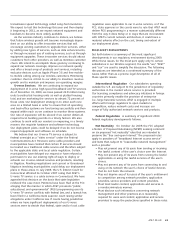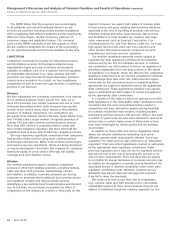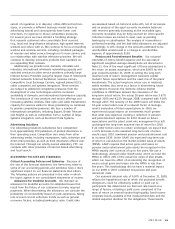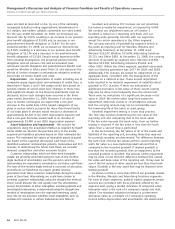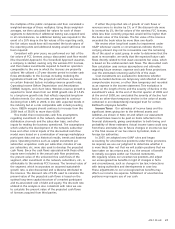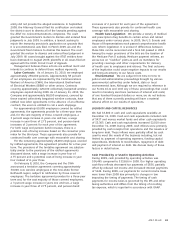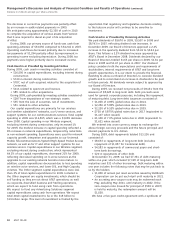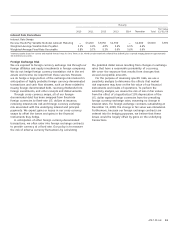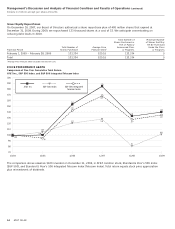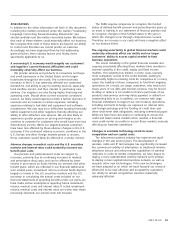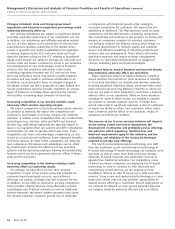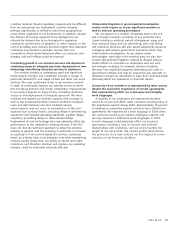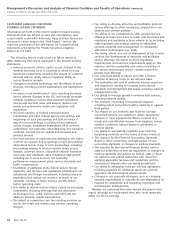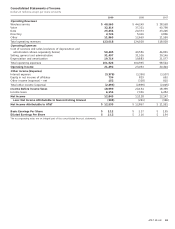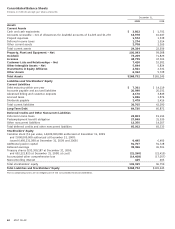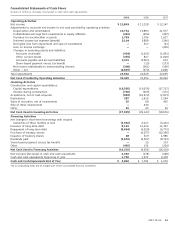AT&T Wireless 2009 Annual Report Download - page 54
Download and view the complete annual report
Please find page 54 of the 2009 AT&T Wireless annual report below. You can navigate through the pages in the report by either clicking on the pages listed below, or by using the keyword search tool below to find specific information within the annual report.
Management’s Discussion and Analysis of Financial Condition and Results of Operations (continued)
Dollars in millions except per share amounts
52 AT&T 09 AR
Contractual Obligations
Payments Due By Period
Less than 1-3 3-5 More than
Total 1 Year Years Years 5 Years
Long-term debt obligations1 $ 70,021 $ 7,328 $12,372 $10,614 $ 39,707
Interest payments on long-term debt 66,233 4,178 7,318 5,990 48,747
Operating lease obligations 20,534 2,429 4,322 3,560 10,223
Unrecognized tax benefits2 5,181 299 – – 4,882
Purchase obligations3 10,228 2,890 4,095 2,549 694
Total Contractual Obligations $172,197 $17,124 $28,107 $22,713 $104,253
1 Represents principal or payoff amounts of notes and debentures at maturity or, for putable debt, the next put opportunity.
2 The non-current portion of the unrecognized tax benefits is included in the “More than 5 Years” column, as we cannot reasonably estimate the timing or amounts of additional
cash payments, if any, at this time. See Note 10 for additional information.
3 We calculated the minimum obligation for certain agreements to purchase goods or services based on termination fees that can be paid to exit the contract. If we elect to exit
these contracts, termination fees for all such contracts in the year of termination could be approximately $404 in 2010, $469 in the aggregate for 2011 and 2012, $113 in the
aggregate for 2013 and 2014 and $3 in the aggregate, thereafter. Certain termination fees are excluded from the above table, as the fees would not be paid every year and the
timing of such payments, if any, is uncertain.
interest rate swaps. We have established interest rate risk
limits that we closely monitor by measuring interest rate
sensitivities in our debt and interest rate derivatives portfolios.
All our foreign-denominated debt has been swapped from
fixed-rate foreign currencies to fixed-rate U.S. dollars at
issuance through cross-currency swaps, removing interest
rate risk and foreign currency exchange risk associated with
the underlying interest and principal payments. Likewise,
periodically we enter into interest rate locks to partially
hedge the risk of increases in the benchmark interest rate
during the period leading up to the probable issuance of
fixed-rate debt. We expect gains or losses in our cross-
currency swaps and interest rate locks to offset the losses
and gains in the financial instruments they hedge.
Following are our interest rate derivatives subject to material
interest rate risk as of December 31, 2009. The interest rates
illustrated below refer to the average rates we expect to pay
based on current and implied forward rates and the average
rates we expect to receive based on derivative contracts.
The notional amount is the principal amount of the debt
subject to the interest rate swap contracts. The fair value
asset (liability) represents the amount we would receive (pay)
if we had exited the contracts as of December 31, 2009.
MARKET RISK
We are exposed to market risks primarily from changes in
interest rates and foreign currency exchange rates. These risks,
along with other business risks, impact our cost of capital. It is
our policy to manage our debt structure and foreign exchange
exposure in order to manage capital costs, control financial
risks and maintain financial flexibility over the long term. In
managing market risks, we employ derivatives according to
documented policies and procedures, including interest rate
swaps, interest rate locks, foreign exchange contracts, and
combined interest rate foreign exchange contracts (cross-
currency swaps). We do not use derivatives for trading or
speculative purposes. We do not foresee significant changes in
the strategies we use to manage market risk in the near future.
Interest Rate Risk
The majority of our financial instruments are medium- and
long-term fixed rate notes and debentures. Changes in
interest rates can lead to significant fluctuations in the fair
value of these instruments. The principal amounts by expected
maturity, average interest rate and fair value of our liabilities
that are exposed to interest rate risk are described in Notes 8
and 9. In managing interest expense, we control our mix of
fixed and floating rate debt, principally through the use of
settlement of such liabilities will not require the use of cash.
However, we have included in the following table obligations
which primarily relate to benefit funding and severance due
to the certainty of the timing of these future payments.
Our other long-term liabilities are: deferred income taxes
(see Note 10) of $23,803; postemployment benefit obligations
(see Note 11) of $27,849; and other noncurrent liabilities
of $13,350, which included deferred lease revenue from
our agreement with American Tower of $509 (see Note 5).
Substantially all of our purchase obligations are in our
Wireline and Wireless segments. The table does not include
the fair value of our interest rate swaps. Our capital lease
obligations and bank borrowings have been excluded from the
table due to the immaterial value at December 31, 2009.
Many of our other noncurrent liabilities have been excluded
from the following table due to the uncertainty of the timing
of payments, combined with the absence of historical trending
to be used as a predictor of such payments. Additionally,
certain other long-term liabilities have been excluded since



